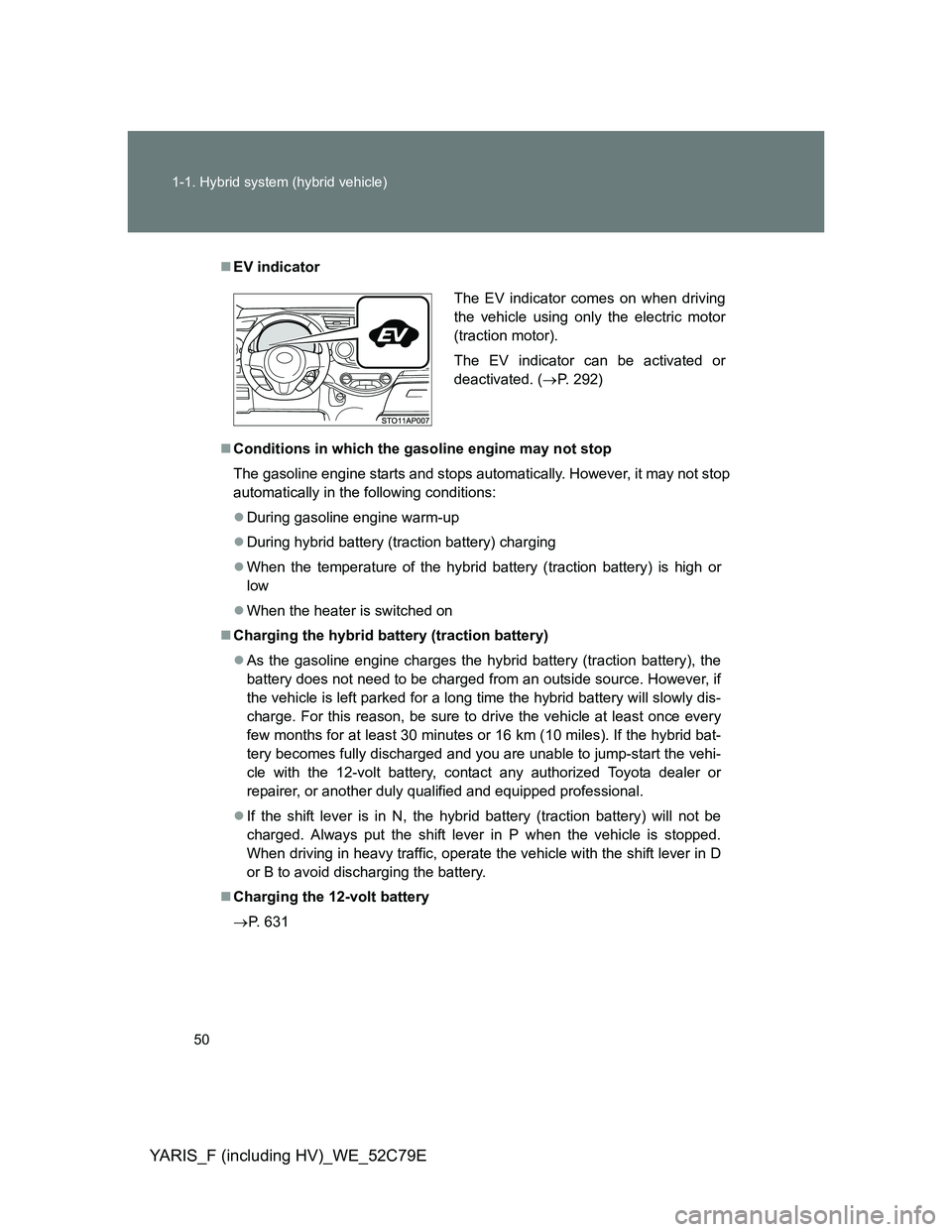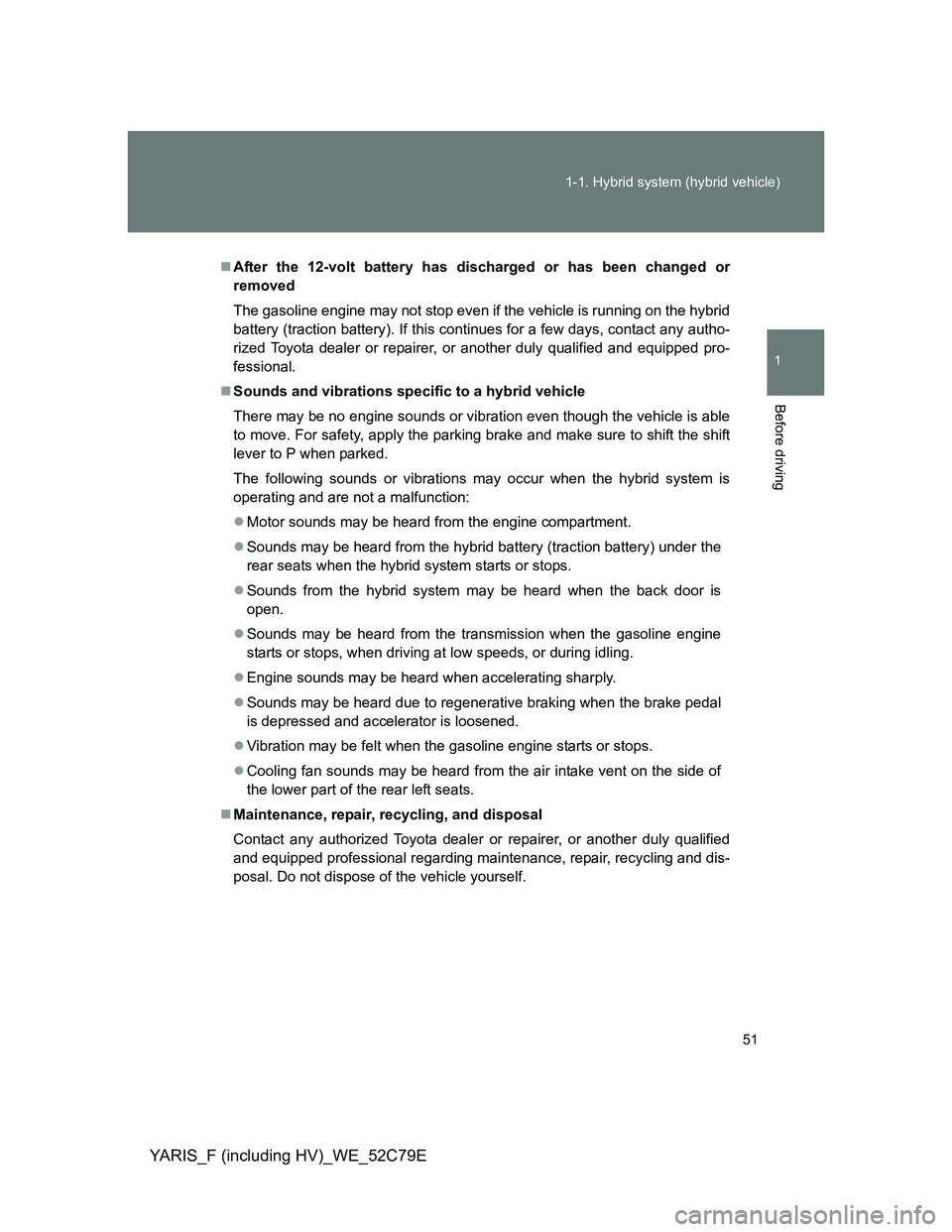Page 47 of 704

1Before driving
47
YARIS_F (including HV)_WE_52C79E
1-1. Hybrid system
(hybrid vehicle)
Hybrid system features ....... 48
Hybrid system
precautions ....................... 52
Energy monitor/
consumption screen ......... 57
Hybrid vehicle driving
tips .................................... 62
1-2. Key information
Keys.................................... 64
1-3. Opening, closing and locking
the doors
Smart entry & start
system .............................. 69
Push-button start
system .............................. 94
Wireless remote control .... 105
Side doors ........................ 114
Back door ......................... 119
1-4. Adjustable components
(seats, mirrors, steering
wheel)
Front seats........................ 124
Rear seats ........................ 127
Head restraints ................. 131
Seat belts.......................... 133
Steering wheel .................. 140Anti-glare inside rear
view mirror ...................... 141
Outside rear view
mirrors ............................ 144
1-5. Opening and closing
the windows
Power windows ................. 147
1-6. Refueling
Opening the fuel tank
cap .................................. 151
1-7. Theft deterrent system
Engine immobilizer/
immobilizer system ......... 155
Double locking system ...... 162
1-8. Safety information
Correct driving posture ..... 164
SRS airbags...................... 166
Airbag manual on-off
system ............................ 177
Child restraint systems ..... 181
Installing child restraints ... 190
Page 49 of 704

49 1-1. Hybrid system (hybrid vehicle)
1
Before driving
YARIS_F (including HV)_WE_52C79E
Regenerative braking
In the following situations, kinetic energy is converted to electric energy and
deceleration force can be obtained in conjunction with the recharging of the
hybrid battery (traction battery).
The accelerator pedal is released.
The brake pedal is depressed with the shift lever in D or B.
When stopped/during start off
The gasoline engine stops
* when the vehicle is stopped. During
start off, the electric motor (traction motor) drives the vehicle. At
slow speeds or when traveling down a gentle slope, the engine
is stopped
* and the motor is used.
*: However, when the hybrid battery (traction battery) needs to be
charged or while the engine is being warmed up, the gasoline engine
may not stop automatically. (P. 50)
During normal driving
The gasoline engine is predominantly used. The electric motor
(traction motor) charges the hybrid battery (traction battery) as
necessary.
When accelerating sharply
The power of the hybrid battery (traction battery) is added to that
of the gasoline engine via the electric motor (traction motor).
When braking (regenerative braking)
The electric motor (traction motor) charges the hybrid battery
(traction battery).
Page 50 of 704

50 1-1. Hybrid system (hybrid vehicle)
YARIS_F (including HV)_WE_52C79E
EV indicator
Conditions in which the gasoline engine may not stop
The gasoline engine starts and stops automatically. However, it may not stop
automatically in the following conditions:
During gasoline engine warm-up
During hybrid battery (traction battery) charging
When the temperature of the hybrid battery (traction battery) is high or
low
When the heater is switched on
Charging the hybrid battery (traction battery)
As the gasoline engine charges the hybrid battery (traction battery), the
battery does not need to be charged from an outside source. However, if
the vehicle is left parked for a long time the hybrid battery will slowly dis-
charge. For this reason, be sure to drive the vehicle at least once every
few months for at least 30 minutes or 16 km (10 miles). If the hybrid bat-
tery becomes fully discharged and you are unable to jump-start the vehi-
cle with the 12-volt battery, contact any authorized Toyota dealer or
repairer, or another duly qualified and equipped professional.
If the shift lever is in N, the hybrid battery (traction battery) will not be
charged. Always put the shift lever in P when the vehicle is stopped.
When driving in heavy traffic, operate the vehicle with the shift lever in D
or B to avoid discharging the battery.
Charging the 12-volt battery
P. 631
The EV indicator comes on when driving
the vehicle using only the electric motor
(traction motor).
The EV indicator can be activated or
deactivated. (P. 292)
Page 51 of 704

51 1-1. Hybrid system (hybrid vehicle)
1
Before driving
YARIS_F (including HV)_WE_52C79E
After the 12-volt battery has discharged or has been changed or
removed
The gasoline engine may not stop even if the vehicle is running on the hybrid
battery (traction battery). If this continues for a few days, contact any autho-
rized Toyota dealer or repairer, or another duly qualified and equipped pro-
fessional.
Sounds and vibrations specific to a hybrid vehicle
There may be no engine sounds or vibration even though the vehicle is able
to move. For safety, apply the parking brake and make sure to shift the shift
lever to P when parked.
The following sounds or vibrations may occur when the hybrid system is
operating and are not a malfunction:
Motor sounds may be heard from the engine compartment.
Sounds may be heard from the hybrid battery (traction battery) under the
rear seats when the hybrid system starts or stops.
Sounds from the hybrid system may be heard when the back door is
open.
Sounds may be heard from the transmission when the gasoline engine
starts or stops, when driving at low speeds, or during idling.
Engine sounds may be heard when accelerating sharply.
Sounds may be heard due to regenerative braking when the brake pedal
is depressed and accelerator is loosened.
Vibration may be felt when the gasoline engine starts or stops.
Cooling fan sounds may be heard from the air intake vent on the side of
the lower part of the rear left seats.
Maintenance, repair, recycling, and disposal
Contact any authorized Toyota dealer or repairer, or another duly qualified
and equipped professional regarding maintenance, repair, recycling and dis-
posal. Do not dispose of the vehicle yourself.
Page 53 of 704

53 1-1. Hybrid system (hybrid vehicle)
1
Before driving
YARIS_F (including HV)_WE_52C79E
Hybrid battery air vent
There is an air intake vent on the
side of the lower part of the rear
left seat for the purpose of cool-
ing the hybrid battery (traction
battery). If the vent becomes
blocked, the hybrid battery (trac-
tion battery) may overheat, lead-
ing to a reduction in hybrid
battery output.
Emergency shut off system
When a certain level of impact is detected by the impact sensor, the
emergency shut off system blocks off the high voltage current and
stops the fuel pump to minimize the risk of electrocution and fuel
leakage. If the emergency shut off system activates, your vehicle will
not restart. To restart the hybrid system, contact any authorized Toy-
ota dealer or repairer, or another duly qualified and equipped profes-
sional.
If a warning light comes on, or the 12-volt battery is disconnected
The hybrid system may not start. In that case, try to start the system again. If
the “READY” indicator does not come on, contact any authorized Toyota
dealer or repairer, or another duly qualified and equipped professional.
Running out of fuel
When the vehicle has run out of fuel and the hybrid system cannot be
started, refuel the vehicle with at least enough gasoline to make the low fuel
level warning light (P. 570) go off. If there is only a small amount of fuel,
the hybrid system may not be able to start. (The minimum amount of fuel to
add to make the low fuel level warning light go out is about 7.0 L [1.8 gal.,
1.5 lmp. gal.] when the vehicle is on a level surface. This value may vary
when the vehicle is on a slope.)
Page 54 of 704

54 1-1. Hybrid system (hybrid vehicle)
YARIS_F (including HV)_WE_52C79E
Electromagnetic waves
High voltage parts and cables on the hybrid vehicles incorporate electro-
magnetic shielding, and therefore emit approximately the same amount
of electromagnetic waves as conventional gasoline powered vehicles or
home electronic appliances.
Your vehicle may cause sound interference in some third party-produced
radio parts.
Hybrid battery (traction battery)
The hybrid battery (traction battery) has a limited service life. The lifespan of
the hybrid battery (traction battery) can change in accordance with driving
style and driving conditions.
CAUTION
High voltage precautions
The vehicle has high voltage DC and AC systems as well as a 12-volt sys-
tem. DC and AC high voltage is very dangerous and can cause severe burns
and electric shock that may result in death or serious injury.
Never touch, disassemble, remove or replace the high voltage parts,
cables or their connectors.
The hybrid system will become hot after starting as the system uses high
voltage. Be careful of both the high voltage and the high temperature, and
always obey the caution labels attached to the vehicle.
The service plug is installed in the
hybrid battery (traction battery). The
service plug is used only when the vehi-
cle is serviced and is subject to high
voltage.
Never touch the service plug, as a mis-
take in handling can lead to an electric
shock.
Page 63 of 704
63 1-1. Hybrid system (hybrid vehicle)
1
Before driving
YARIS_F (including HV)_WE_52C79E
Checking tire inflation pressure
Make sure to check the tire inflation pressure frequently. Improper tire
inflation pressure can cause poor fuel consumption.
Also, as snow tires can cause large amounts of friction, their use on dry
roads can lead to poor fuel consumption. Use a tire that is appropriate
for the season.
Luggage
Carrying heavy luggage can lead to poor fuel consumption. Avoid car-
rying unnecessary luggage. Installing a large roof rack can also cause
poor fuel consumption.
Warming up before driving
Since the gasoline engine starts up and cuts out automatically when
cold, warming up the engine is unnecessary. Moreover, frequently driv-
ing short distances will cause the engine to repeatedly warm up, which
can lead to poor fuel consumption.
Page 64 of 704
64
YARIS_F (including HV)_WE_52C79E
1-2. Key information
Keys
The following keys are provided with the vehicle.
Vehicles without a smart entry & start system or a push-but-
ton start system (type A)
Keys
Key number plate
Vehicles without a smart entry & start system or a push-but-
ton start system (type B)
Key (with a wireless remote
control function)
Operating the wireless remote
control function (P. 105)
Key (without a wireless
remote control function)
Key number plate
Vehicles without a smart entry & start system or a push-but-
ton start system (type C)
Keys
Operating the wireless remote
control function (P. 105)
Key number plate